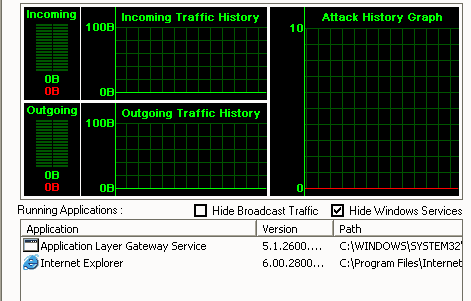
ATTENTION: This firewall is no longer supported!
Sygate Personal Firewall is one of the best free firewalls: it is simple in use, complete, professional and easy to understand. Sygate Personal Firewall makes it possible to block or allow any application. If an unknown application would like to have access to the internet, you are asked what to do in a clear manner, as you will see below. Sygate has been bought and killed by Symantec because the free Sygate version was killing the market for their own Norton firewall. For this reason, Sygate can no longer be downloaded (and this article won't be updated anymore).
The Sygate firewall setup is very easy. After you restarted Windows the two gray arrows icon from the Sygate firewall is placed in the system tray. First thing you have to do is a online registration (else you will be asked every restart of Windows). The two gray arrows become blue when there is allowed internet traffic and red when there is blocked internet traffic. Double clicking on the double arrow will show you the Sygate Personal Firewall screen, as you can see below:

The upper graph show the incoming traffic, the lower graph show the outgoing traffic. The graph on the left shows the current traffic, while the history is visible in the middle graph. The Attack History Graph shows blocked traffic.
In the lower frame you see the running applications for this moment: each program with possible internet access is shown here. Most of them will be from Windows, as you can check by enabling the option Hide Windows Services (you can allow them). After a fresh installation of Sygate Personal Firewall, you will be asked by a few applications, whether they are allowed to access the internet or not. This is done by the follow question on your screen:

|
|
Before you confirm allowance to the internet, you better enable the option Remember my answer, and do not ask me again for this application. If you don't enable the remember option, you will be asked again if the application is started again. Applications which you didn't allow permanent internet access yet, will be shown in the Sygate Personal Firewall screen with a yellow question mark. There you can change the status from Allow, Ask (the yellow question mark) and Block, as shown below:

Every time an application is trying to access the internet, Sygate checks whether you have allowed the access. If there hasn't been asked yet, you will be. If you have already blocked the application, you will be noticed about the blocked traffic.
BE AWARE: If you don't trust an application, don't allow it to enter the internet, just press No. If something goes wrong, you can always Allow the application in the Sygate screen or after a restart.
Click Tools, Options to enter the Sygate options menu: here you have some extra security options. On the first tab enable the option Hide notification messages, to avoid the frequent appearance of the pop-ups. By clicking Tools, Logs you can view the traffic log files. If you want to know where some traffic has come from, you can BackTrace IP addresses by right clicking on a specific log item.
BLCOK INCOMMING ICMP TRAFFICIt is still possible to do a status request of your computer by doing a ping command. You can disable this vulnerability by adding an advanced rule to the firewall. Click Tools, Advanced Rules and click the Add button. At Rule Description you enter ICMP (Internet Control Message Protocol). The Action has to be Block this traffic. At the tab Ports and Protocols you select ICMP from the combo box, and then the Select All button. Furthermore change the Traffic Direction in Incoming and click OK. |
© 2001-2022 - Menno Schoone - SchoonePC - Rotterdam - The Netherlands